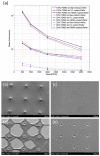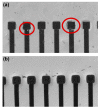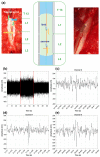Plateau-Shaped Flexible Polymer Microelectrode Array for Neural Recording
- PMID: 30965988
- PMCID: PMC6418796
- DOI: 10.3390/polym9120690
Plateau-Shaped Flexible Polymer Microelectrode Array for Neural Recording
Abstract
Conventional polymer multielectrode arrays (MEAs) have limitations resulting from a high Young's modulus, including low conformability and gaps between the electrodes and neurons. These gaps are not a problem in soft tissues such as the brain, due to the repopulation phenomenon. However, gaps can result in signal degradation when recording from a fiber bundle, such as the spinal cord. Methods: We propose a method for fabricating flexible polydimethylsiloxane (PDMS)-based MEAs featuring plateau-shaped microelectrodes. The proposed fabrication technique enables the electrodes on the surface of MEAs to make a tight connection to the neurons, because the wire of the MEA is fabricated to be plateau-shaped, as the Young's modulus of PDMS is similar to soft tissues and PDMS follows the curvature of the neural tissue due to its high conformability compared to the other polymers. Injury caused by the movement of the MEAs can therefore be minimized. Each electrode has a diameter of 130 μm and the 8-channel array has a center-to-center electrode spacing of 300 μm. The signal-to-noise ratio of the plateau-shaped electrodes was larger than that of recessed electrodes because there was no space between the electrode and neural cell. Reliable neural recordings were possible by adjusting the position of the electrode during the experiment without trapping air under the electrodes. Simultaneous multi-channel neural recordings were successfully achieved from the spinal cord of rodents. We describe the fabrication technique, electrode 3D profile, electrode impedance, and MEA performance in in vivo experiments in rodents.
Keywords: PDMS; PDMS etching; fabrication; multielectrode array (MEA); plateau-shaped electrode; recessed electrode; spinal cord signal recording; underexposure.
Conflict of interest statement
The authors declare no conflict of interest.
Figures










References
LinkOut - more resources
Full Text Sources

